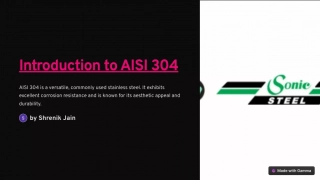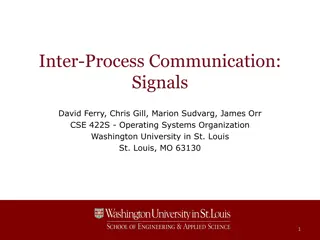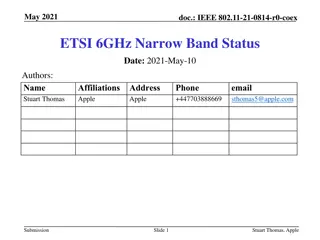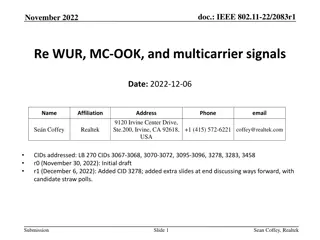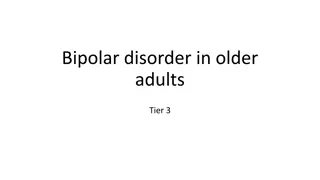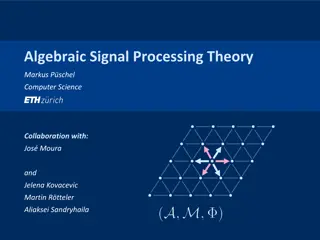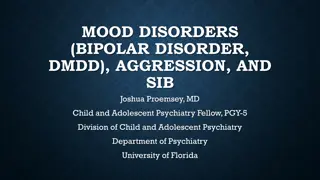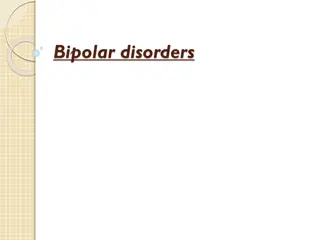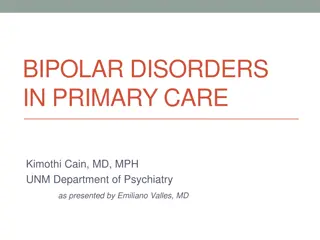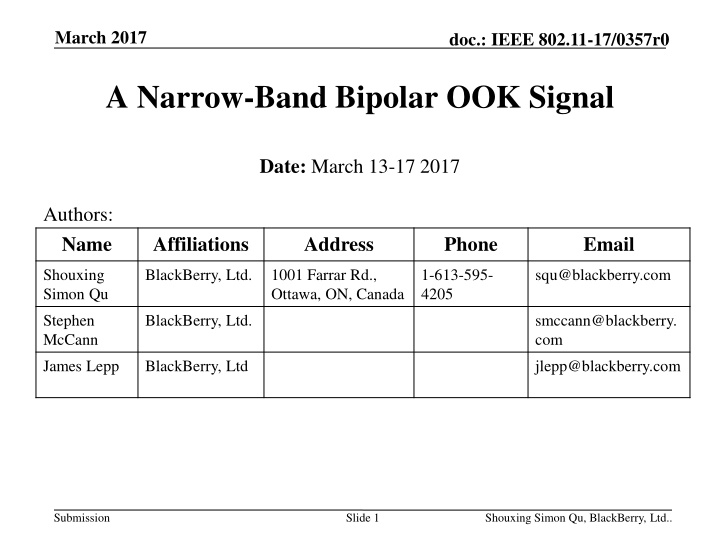
NBB OOK Signal for Wireless Applications
"Explore the innovative Narrow-Band Bipolar OOK signal proposed for Wireless Ultra-Short-Range communication. This signal offers higher spectrum efficiency with minimal transmitter complexity and retains error rate performance. Discover the benefits and implementation details of this cutting-edge technology." (320 characters)
Download Presentation

Please find below an Image/Link to download the presentation.
The content on the website is provided AS IS for your information and personal use only. It may not be sold, licensed, or shared on other websites without obtaining consent from the author. If you encounter any issues during the download, it is possible that the publisher has removed the file from their server.
You are allowed to download the files provided on this website for personal or commercial use, subject to the condition that they are used lawfully. All files are the property of their respective owners.
The content on the website is provided AS IS for your information and personal use only. It may not be sold, licensed, or shared on other websites without obtaining consent from the author.
E N D
Presentation Transcript
March 2017 doc.: IEEE 802.11-17/0357r0 A Narrow-Band Bipolar OOK Signal Date: March 13-17 2017 Authors: Name Affiliations Address Phone Email Shouxing Simon Qu BlackBerry, Ltd. 1001 Farrar Rd., Ottawa, ON, Canada 1-613-595- 4205 squ@blackberry.com Stephen McCann BlackBerry, Ltd. smccann@blackberry. com James Lepp BlackBerry, Ltd jlepp@blackberry.com Submission Slide 1 Shouxing Simon Qu, BlackBerry, Ltd..
March 2017 doc.: IEEE 802.11-17/0357r0 Abstract A narrow-band bipolar OOK (NBB OOK) signal is proposed in this contribution. On-off keying (OOK) is a potential candidate modulation scheme for WUR [1]. The spectrum efficiency of regular non-return-to-zero (NRZ) OOK signal is analyzed. The spectrum efficiency of NBB OOK signal is higher compared to the regular OOK signal. Submission Slide 2 Shouxing Simon Qu, BlackBerry, Ltd.. ..
March 2017 doc.: IEEE 802.11-17/0357r0 NRZ OOK Signal (1) Conceptual NRZ OOK Signal Generator: NRZ OOK Baseband Waveform: Submission Shouxing Simon Qu, BlackBerry, Ltd..
March 2017 doc.: IEEE 802.11-17/0357r0 NRZ OOK Signal (2) Baseband OOK signal: ? ?? ? , (1) ? ? = ??? ? {??}: input bit stream, independently takes 1 or 0 with equal probability. ? ? : a non-return-to zero (NRZ) pulse, ? ? = 1, ??? 0 ? < 1 0, ?? ?????? . (2) Non-coherent detection: Envelope detector (ED), i.e. detection based on the absolute value of Rx baseband signal. Submission Slide 4 Shouxing Simon Qu, BlackBerry, Ltd.. ..
March 2017 doc.: IEEE 802.11-17/0357r0 Normalized PSD of NRZ OOK Signal ? ? = ? |???? ?? |2 (3) o null-to-null bandwidth: W = 2/T. o has non-zero discrete DC component (not shown). Submission Shouxing Simon Qu, BlackBerry, Ltd..
March 2017 doc.: IEEE 802.11-17/0357r0 Motivation for Narrow-Band Bipolar OOK Proposing a new signal suitable for WUR. Providing higher spectrum efficiency. Slightly increasing transmitter complexity. Do not increase receiver complexity: The new signal can be demodulated with the same envelope detector (ED) used as for the above OOK. Same error rate performance in AWGN channel. Submission Slide 6 Dmitry Cherniavsky, SiBEAM, Inc.
March 2017 Narrow-Band Bipolar (NBB) OOK (1) doc.: IEEE 802.11-17/0357r0 NBB OOK Baseband Waveform: Bipolar: with three levels: {+1, 0 -1}. Adjacent pulses have same polarity; Non-adjacent pulses have alternate polarities. Level varies cyclically: +1 0 -1 0 +1 Submission Slide 7 Shouxing Simon Qu, BlackBerry, Ltd..
March 2017 doc.: IEEE 802.11-17/0357r0 Narrow-Band Bipolar OOK (2) Baseband signal: ? ?? ? , (4) ? ? = ???? where, ??= ?? ?? 1 ?? 1 ?? 1 ????(?), (5) ????(?): the last-non-zero symbol. Submission Slide 8 Shouxing Simon Qu, BlackBerry, Ltd..
March 2017 doc.: IEEE 802.11-17/0357r0 Narrow-Band Bipolar OOK (3) Encoding Rule: If ??= 0, ??= 0; otherwise, ??= 1. If ??= ?? 1= 1, ??= ?? 1, i.e. transmit the same pulse as previous one; otherwise, if ??= 1 and ?? 1= 0, ??= ????(?), i.e. transmitting the pulse with opposite polarity of the last- non-zero pulse. Non-coherent detection: with the same envelope detector as for the NRZ OOK. Submission Slide 9 Shouxing Simon Qu, BlackBerry, Ltd..
March 2017 doc.: IEEE 802.11-17/0357r0 Narrow-Band Bipolar OOK (4) NBB OOK Signal Generator: the switch moves as 1 0 -1 0 Submission Slide 10 Shouxing Simon Qu, BlackBerry, Ltd..
March 2017 doc.: IEEE 802.11-17/0357r0 Switch Connection Whenever ??= 0, the output of the switch is connected to Terminal 0 and stays there until an input bit of 1 arrives. When ??changes from 0 to 1: if the output previously switched from Terminal 1 to 0 , it switches to Terminal -1 , and stays there until an input bit of 0 arrives. if the output previously switched from Terminal -1 to Terminal 0 , it switches to Terminal 1 , and stays there until an input bit of 0 arrives. Submission Slide 11 Shouxing Simon Qu, BlackBerry, Ltd..
March 2017 doc.: IEEE 802.11-17/0357r0 Normalized PSD of NBB OOK 3 2 cos 2??? 2 ? ? = ? ???? ?? 9 12 cos 2??? +4 cos 4??? (6) oNo discrete DC component. Submission Shouxing Simon Qu, BlackBerry, Ltd..
March 2017 doc.: IEEE 802.11-17/0357r0 PSD of OOK Signals (theoretical, Eq.(6)) Submission Shouxing Simon Qu, BlackBerry, Ltd..
March 2017 doc.: IEEE 802.11-17/0357r0 PSD of NBB OOK Signal (simulation results) Submission Shouxing Simon Qu, BlackBerry, Ltd..
March 2017 doc.: IEEE 802.11-17/0357r0 Bandwidth Efficiency Comparison Double-Sided Bandwidth (f T) 0.5 0.6 0.8 1.0 1.2 1.4 1.6 1.8 2.0 Energy Ratio within Given Bandwidth (%) NRZ OOK 46.7 54.5 67.6 77.4 83.9 87.8 89.6 90.2 90.3 NBB OOK 80.4 84.1 87.9 90.0 91.4 92.5 93.6 94.8 95.0 Submission Slide 15 Shouxing Simon Qu, BlackBerry, Ltd..
March 2017 doc.: IEEE 802.11-17/0357r0 Conclusions By introducing proper correlation among symbols, the proposed narrow-band bipolar OOK signal provides improved spectrum/bandwidth efficiency. The bandwidth needed to transmit the NBB OOK signal is significantly narrower than to transmit the NRZ OOK signal. The out-of-band energy leakage is reduced. No increase of Rx complexity: o Demodulation with the same ED for the NRZ OOK; yielding same error rate performance in AWGN channel. Transmitter complexity increases slightly. The principle is applicable to other unipolar binary signals. Submission Slide 16 Shouxing Simon Qu, BlackBerry, Ltd..
March 2017 doc.: IEEE 802.11-17/0357r0 REFERENCES : [1] ] Minyoung Park at.al, LP-WUR (Low-Power Wake-Up Receiver) Follow-Up , IEEE 802.11-16/0341r0, Mar. 14, 2016. [2] S. Benedetto, E. Biglieri and V. Castellani, Digital Transmission Theory, Prentice-Hall, 1988. Submission Slide 17 Shouxing Simon Qu, BlackBerry, Ltd..

